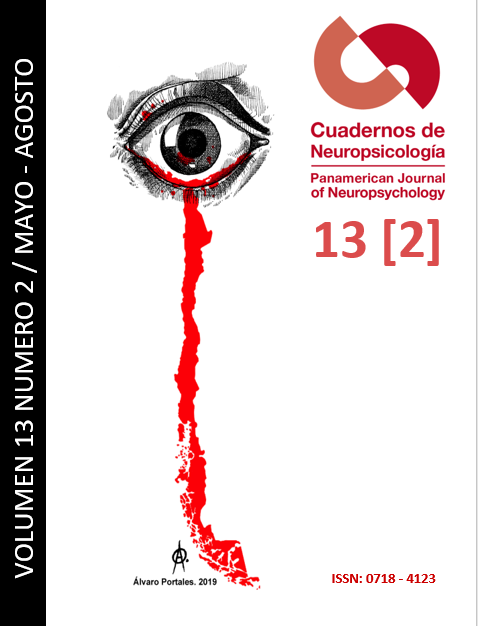Diferencias en el desempeño en una tarea de planificación según la motivación de niñas y niños preescolares
Abstract
Resumen:
La motivación puede definirse como un conjunto de creencias, valores y emociones que influyen la forma en que un individuo afronta una actividad. La planificación es un proceso autorregulatorio involucrado en la creación y mantenimiento de una secuencia de pasos orientados a resolver una tarea. La literatura aborda la asociación entre motivación y procesos autorregulatorios, pero no especÃficamente considerando una tarea con demandas de planificación. El objetivo de este trabajo es analizar la relación entre la planificación y la motivación acerca de esa tarea, en términos de valor intrÃnseco y habilidad percibida, en niñas y niños de 4 años, y explorar las variaciones que se presentan en esa relación según la dificultad de la tarea. Se administró la tarea Torre de Londres (ToL) y un reporte de la motivación a 27 niñas y niños de 4 años. Los resultados evidenciaron que las niñas y los niños que reportaron mayor valor intrÃnseco por la tarea (i.e., disfrute e interés) tuvieron un mayor desempeño en ToL, particularmente en los ensayos con mayor demanda.
Palabras claves: Reporte de investigación; motivación; planificación; preescolares; valor intrÃnseco; dificultad.
Â
Abstract:
Motivation is a set of beliefs, values and emotions that influence the way an individual faces an activity. Planning is a self-regulatory process, the ability to create and maintain an appropriate sequence of steps to solve a task. The literature explores the association between motivation and self-regulatory processes, but not specifically in a task with planning demands. The objective of this paper is to analyze the relationship between planning and motivation about this task in terms of intrinsic value and perceived ability, in 4-year-old girls and boys, and to explore the variations in that relationship, according to the difficulty of the task. They were administered the task Torre de Londres (ToL) and a report of the motivation about that task to 27 children in the 4-year-old. The results showed that the girls and boys who reported higher intrinsic value - enjoyment and interest - for the task had a higher performance in ToL, particularly in trials that produce greater demand.
Key words: motivation; planning; preschoolers; intrinsic value; difficulty.
Â
Resumo:
A motivação pode ser definida como um conjunto de realizações, valores e emoções que influenciam a maneira pela qual um indivÃduo enfrenta uma atividade. O planejamento é um processo de auto-regulação envolvido na criação e manutenção de uma sequência de paÃses com o objetivo de resolver uma tarefa. A literatura trata da associação entre processos de motivação e auto-regulação, mas considera especificamente uma tabela com demandas de planejamento. O objetivo deste trabalho é analisar a relação entre planejamento e motivação nessa tarefa, em termos de valor intrÃnseco e capacidade percebida, em 4 anos, e explorar as variações que estão presentes nessa relação como resultado da dificuldade. daÃ. É administrado a Torre de Londres (ToL) e um relatório motivacional para 27 crianças e crianças de 4 anos de idade. Os resultados mostram que crianças e crianças que relatam maior valor intrÃnseco por parte do objetivo (ou seja, gozo e interesse) têm maior desempenho na TOL, principalmente em ensaios com maior demanda.
Palavras-chave: relatório de pesquisa; planeamento de motivação; valor intrÃnseco da pré-escola; difÃcildade.
Downloads
How to Cite
Issue
Section
License
Articles published in this journal are protected under the Creative Commons Attribution-NonCommercial-ShareAlike 4.0 International (CC BY-NC-SA 4.0) license. This means that authors retain full rights over their research and publications at all times. As a journal, we fully respect and promote the principles of open access established by this license, allowing the work to be shared, adapted, and distributed for non-commercial purposes, provided that appropriate credit is given to the authors and any derivative works are licensed under the same terms.
Authors are responsible for obtaining the required permission when they wish to reproduce part of the material (figures, etc.) from other publications.
Likewise, CNPs allows authors to host in their personal sites or other repositories that they deem convenient the Final and Definitive Version of the published article with the format assigned by the journal. In no case do we allow access to preprints of the article under evaluation or already published.
When submitting an article to CNPs you are aware that all the contents of CNPs are under a Creative Commons License. In which it is allowed to copy and share the contents freely, always making reference to the origin of the publication and its author.





